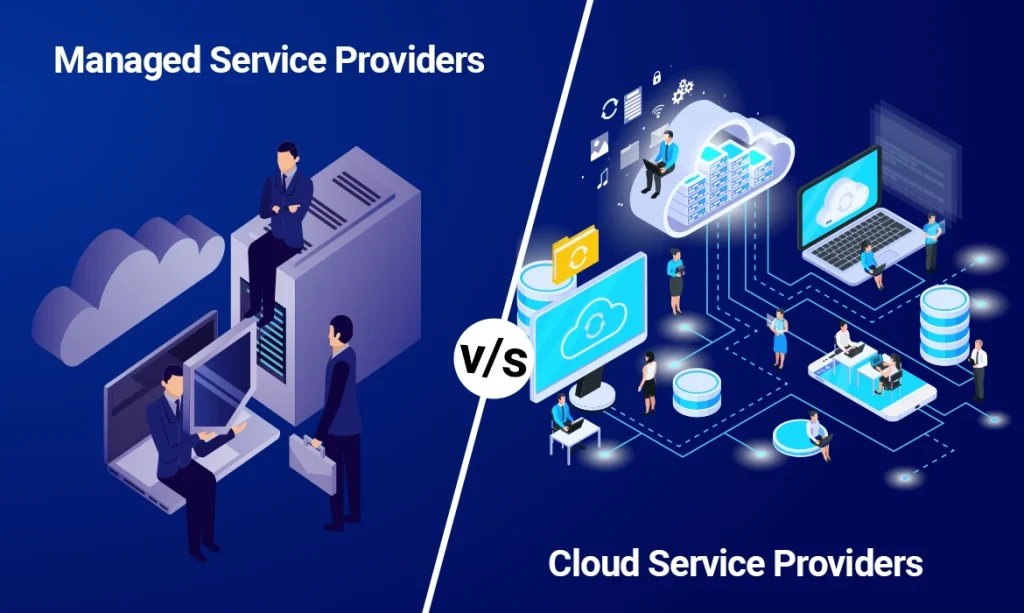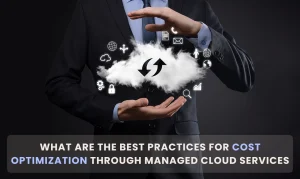Businesses in the fast-paced world of information technology (IT) face a plethora of options for meeting their technical requirements. Two important firms stand out among these options: Managed Service Providers (MSPs) and Cloud Service Providers (CSPs). Understanding the differences between these entities is critical for businesses looking to improve their IT infrastructure and operations.
Table of Contents
Managed Service Providers (MSPs)
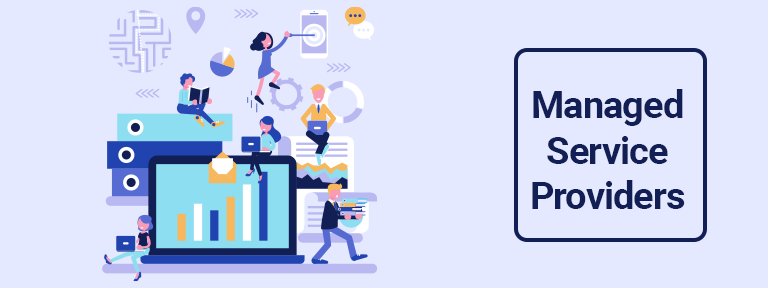
Managed Service Providers operate on the premise of offering a comprehensive suite of services to oversee an organization’s IT needs. These services span from infrastructure management and network monitoring to cybersecurity, data backup, and end-user support. The primary objective of MSPs is to act as an extension of an organisation’s IT department, providing specialised expertise across a spectrum of functions.
One of the key advantages of engaging with an MSP lies in the access to a diverse team of skilled professionals. Instead of maintaining an in-house team for every aspect of IT, businesses can leverage the expertise of an MSP on a subscription-based model. This not only ensures cost predictability but also allows for a proactive approach to IT maintenance and issue resolution.
MSPs play a pivotal role in enhancing the overall efficiency of IT operations. By outsourcing routine tasks and responsibilities, internal IT teams can focus on strategic initiatives and core business objectives. Moreover, MSPs often offer 24/7 monitoring and support, ensuring that potential issues are identified and addressed promptly, minimizing downtime.
Examples of Managed Service Providers (MSPs):
- IBM Managed Services: Offers a range of managed IT services, including cloud computing, cybersecurity, and infrastructure management.
- Accenture Managed Services: Provides comprehensive IT outsourcing solutions, consulting, and digital services for businesses.
- Datto: Specializes in backup and disaster recovery solutions, offering managed services for data protection.
Common services provided by MSPs:
Managed Service Providers (MSPs) typically offer a range of services aimed at outsourcing and optimizing IT operations for businesses.
- IT Support and Help Desk: Providing technical assistance and troubleshooting for end-users.
- Network Monitoring and Management: Ensuring the stability and security of the client’s network infrastructure.
- Providing cybersecurity services involves implementing and overseeing security measures to safeguard against potential cyber threats.
- Data Backup and Recovery: Safeguarding data by implementing backup solutions and facilitating recovery when necessary.
- Cloud Computing Services: Managing and optimizing cloud infrastructure, applications, and services.
- Infrastructure Management: Overseeing hardware, software, and IT infrastructure to ensure optimal performance.
- Vendor Management: Handling relationships with third-party vendors and ensuring software and hardware integrations.
Cloud Service Providers (CSPs)
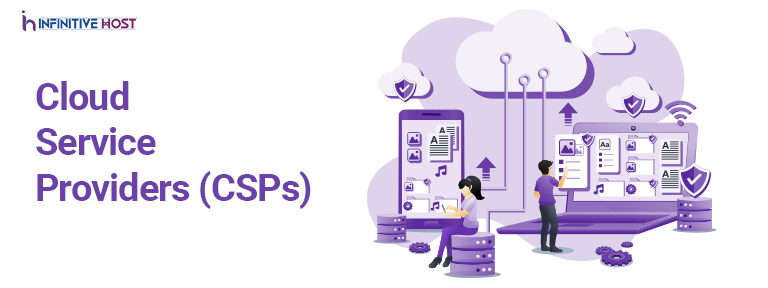
In contrast to MSPs, Cloud Service Providers concentrate on delivering computing resources and services through the cloud. These resources encompass storage, processing power, databases, networking, and more. The cloud infrastructure eliminates the need for on-premises hardware, offering businesses the flexibility to scale their IT resources based on demand.
CSPs operate through various service models, including Infrastructure as a Service (IaaS), Platform as a Service (PaaS), and Software as a Service (SaaS). This versatility allows organizations to choose the level of control and customization that aligns with their specific requirements. Prominent CSPs in the industry include Amazon Web Services (AWS), Microsoft Azure, and Google Cloud Platform (GCP).
Cloud computing provides a range of benefits, including cost efficiency, scalability, and accessibility. Organizations can reduce capital expenditures by paying only for the resources they consume, scale their infrastructure up or down as needed, and access their data and applications from anywhere with an internet connection.
Examples of Control Service Providers (CSPs):
- Microsoft Azure: A cloud computing platform that serves as a Control Service Provider, offering various services for building, deploying, and managing applications.
- Amazon Web Services (AWS): Another major CSP, delivering on-demand cloud computing services and solutions for businesses worldwide.
- Google Cloud Platform (GCP): Operates as a Control Service Provider, offering cloud computing and storage services, machine learning, and data analytics.
Key services provided by CSPs:
Control Service Providers (CSPs), on the other hand, focus on delivering cloud computing services and solutions that give clients control over their IT resources.
- Infrastructure as a Service (IaaS) provides virtualized computing resources over the internet, offering scalable and flexible infrastructure for businesses.
- Platform as a Service (PaaS): Providing a platform that allows clients to develop, run, and manage applications without dealing with the complexities of infrastructure.
- Software as a Service (SaaS) involves delivering software applications over the internet through a subscription-based model.
- Data Storage and Management: Offering scalable and secure data storage solutions.
- Identity and Access Management (IAM): Providing tools to manage user identities and control access to resources.
- Monitoring and Analytics: Supplying tools for monitoring performance, gathering insights, and analyzing data.
- Serverless Computing: Enabling clients to run applications without managing server infrastructure.
Key Differences Between MSPs and CSPs:
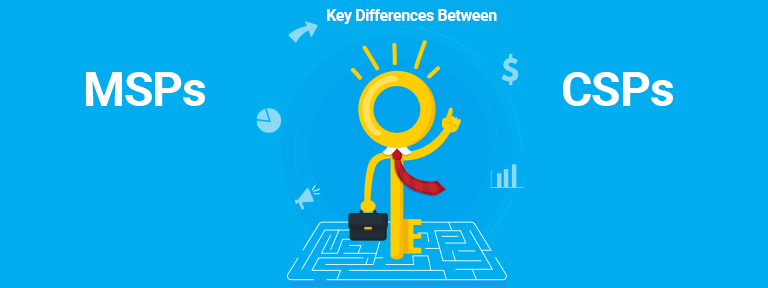
To make an informed decision between MSPs and CSPs, it’s essential to understand the fundamental differences between the two:
Scope of Services:
- MSPs: Offer a wide range of IT services, including proactive management, support, and strategic planning.
- CSPs: Primarily provide infrastructure and software services through the cloud.
Infrastructure Ownership:
- MSPs: Typically manage existing on-premises infrastructure or co-located data centers.
- CSPs: Own and operate the cloud infrastructure, offering services on a pay-as-you-go model.
Focus on IT Management:
- MSPs: Concentrate on managing and maintaining an organization’s IT environment.
- CSPs: Focus on providing scalable and flexible computing resources through the cloud.
Cost Structure:
- MSPs: Often operate on a monthly subscription model based on the services provided.
- CSPs: Charge based on resource consumption, providing flexibility for businesses to scale up or down as needed.
Choosing the Right Fit:

The decision between an MSP and a CSP hinges on the specific needs and goals of an organization. For companies seeking comprehensive IT management and support, an MSP is an ideal partner. On the other hand, those prioritizing scalable and on-demand cloud resources may opt for the services of a CSP.
In some cases, businesses may adopt a hybrid approach, combining the strengths of both MSPs and CSPs to create a tailored IT solution. This hybrid model allows organizations to leverage the expertise of an MSP for day-to-day operations while utilizing the scalability and flexibility of the cloud for specific functions.
Regardless of the choice, the key lies in aligning IT services with the broader goals and growth trajectory of the organization. It’s essential to conduct a thorough assessment of current and future IT needs, considering factors such as scalability, cost efficiency, and the level of control required.
Conclusion:
In the rapidly evolving landscape of IT services, the roles of Managed Service Providers and Cloud Service Providers are distinctive yet complementary. MSPs excel in providing holistic IT management, offering a wide array of services to support day-to-day operations and strategic initiatives. On the other hand, CSPs empower organizations with the flexibility of cloud computing, enabling scalable and on-demand access to resources.
The choice between MSPs and CSPs is not about one being better than the other; rather, it’s about selecting the right fit for the unique requirements of a business. By understanding the strengths and focus areas of each, organizations can make informed decisions that align with their IT strategy, ensuring efficiency, scalability, and long-term success. Whether it’s the comprehensive support of an MSP or the agility of cloud resources provided by a CSP, the key is to embrace a solution that propels the organization towards its goals in the ever-evolving digital landscape.
Also Read:- VPS Hosting Vs Cloud Hosting: What Is The Difference?


